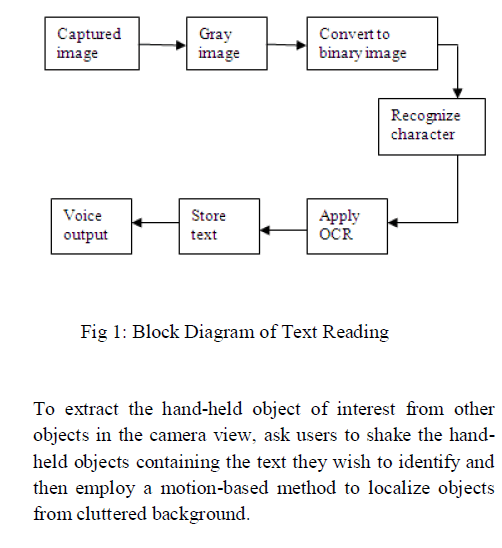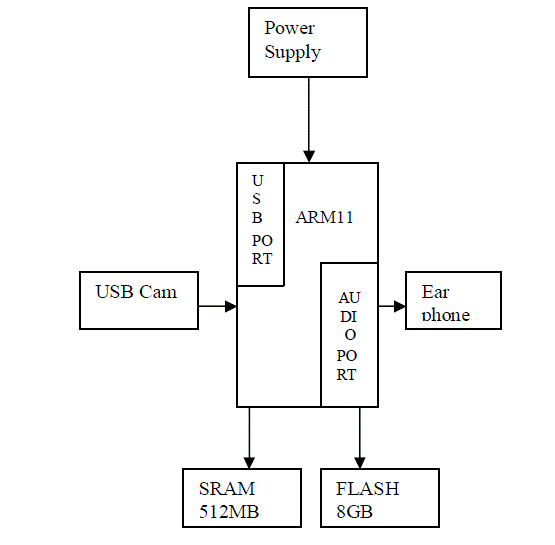A camera based assistive text reading framework to help blind persons read text labels and product packaging from hand-held object in their daily resides is proposed. To isolate the object from cluttered backgrounds or other surroundings objects in the camera view, we propose an efficient and effective motion based method to define a region of interest (ROI) in the video by asking the user to shake the object. In the extracted ROI, text localization and recognition are conducted to acquire text information. To automatically localize the text regions from the object ROI, we propose a novel text localization algorithm by learning gradient features of stroke orientations and distributions of edge pixels in an Adaboost model. Text characters in the localized text regions are then binarized and recognized by off-theshelf optical character recognition software. The recognized text codes are output to blind users in speech.
Keywords |
| Assistive devices, blindness, distribution of
edge pixels, hand-held objects, optical character
recognition (OCR), stroke orientation, text reading
and text region localization. |
INTRODUCTION |
| Of the 314 million visually impaired people worldwide,
45 million are blind. Recent developments in computer
vision, digital cameras and portable computers make it
feasible to assist these individuals by developing camera
based products that combine computer vision technology
with other existing commercial products such optical
character recognition (OCR) systems. |
| Reading is obviously essential in today’s society. Printed
text is everywhere in the form of reports, receipts, bank
statements, restaurant menus, classroom handouts,
product packages, instructions on medicine bottles, etc.
The ability of people who are blind or have significant
visual impairments to read printed labels and product
packages will enhance independent living and foster
economic and social self-sufficiency. Today, there are
already a few systems that have some promise for
portable use, but they cannot handle product labelling. |
| For example, portable bar code readers designed to help
blind people identify different products in an extensive
product database can enable users who are blind to access
information about these products through speech and
braille. But a big limitation is that it is very hard for blind
users to find the position of the bar code and to correctly
point the bar code reader at the bar code. Some reading
assistive systems such as pen scanner might be employed
in these and similar situations. |
| Although a number of reading assistants have been
designed specifically for the visually impaired, to our
knowledge, no existing reading assistant can read text
from the kinds of challenging patterns and backgrounds
found on many everyday commercial products. To assist
blind persons to read text from these kinds of hand-held
objects, we have conceived of a camera based assistive
text reading framework to track the object of interest
within the camera view and extract print text information
from the object. Our proposed algorithm can effectively
handle complex background and multiple patterns, and
extract text information from both hand-held objects and
nearby signage. |
SOFTWARE SPECIFICATIONS AND
FRAMEWORK |
| Software Specifications |
| Operating System : Ubuntu 12.04 |
| Language : C and C++ |
| Platform : OpenCV (linux-library) |
| Framework |
| This paper presents a prototype system of assistive
text reading. The system framework consists of three
functional components: scene capture, data processing,
and audio output. The scene capture component collects
scenes containing objects of interest in the form of
images or video. In our prototype, it corresponds to a
camera attached to a pair of sunglasses. The data
processing component is used for deploying our proposed
algorithms, including 1) object- of- interest detection to selectively extract the image of the object held by the
blind user from the cluttered background or other neutral
objects in the camera view; and 2) text localization to
obtain image regions containing text, and text recognition
to transform image-based text information into readable
codes. We use a mini laptop as the processing device in
our current prototype system. The audio output
component is to inform the blind user of recognized text
codes. |
IMAGE CAPTURING AND PRE-PROCESSING |
| The video is captured by using web-cam and the frames
from the video is segregated and undergone to the preprocessing.
First, get the objects continuously from the
camera and adapted to process. Once the object of
interest is extracted from the camera image and it
converted into gray image. Use haar cascade classifier for
recognizing the character from the object. The work with
a cascade classifier includes two major stages: training
and detection. For training need a set of samples. There
are two types of samples: positive and negative. |
 |
AUTOMATIC TEXT EXTRACTION |
| In order to handle complex backgrounds, two
novel feature maps to extracts text features based on
stroke orientations and edge distributions, respectively.
Here, stroke is defined as a uniform region with bounded
width and significant extent. These feature maps are
combined to build an Adaboost based text classifier. |
TEXT REGION LOCALIZATION |
| Text localization is then performed on the camera based
image. The Cascade-Adaboost classifier confirms the
existence of text information in an image patch but it
cannot the whole images, so heuristic layout analysis is
performed to extract candidate image patches prepared
for text classification. Text information in the image
usually appears in the form of horizontal text strings
containing no less than three character members. |
TEXT RECOGNITION AND AUDIO OUTPUT |
| Text recognition is performed by off-the-shelf OCR prior
to output of informative words from the localized text
regions. A text region labels the minimum rectangular
area for the accommodation of characters inside it, so the
border of the text region contacts the edge boundary of
the text characters. However, this experiment show that
OCR generates better performance text regions are first
assigned proper margin areas and binarized to segments
text characters from background. |
| The recognized text codes are recorded in script files.
Then, employ the Microsoft Speech Software
Development Kit to load these files and display the audio
output of text information. Blind users can adjust speech
rate, volume and tone according to their preferences. |
HARDWARE DESCRIPTION |
| Block Diagram |
 |
| Fig 2: Block Diagram of Vision Based Assistive System |
| Block Diagram Description |
| The block diagram consists of ARM11 micro
controller (BCM2835), USB cam, Power supply, Flash
memory, SRAM and Earphone. The camera is connected
to an ARM11 (BCM2835) by a USB connection and it
can capture the hand-held object appears in the camera
view. LAN9512 is interface with the system to view the
monitor. SRAM is used for the temporary storage and
flash memory is used for the permanent storage. The
ARM11 (BCM2835) performs the processing and
provides audio output through earphone. |
| Hardware Requirements |
| Power Supply Unit |
| USB cam |
| SRAM |
| ARM11 (BCM2835) |
| Flash memory |
| Ear phone |
| USB cameras are imaging cameras that use USB 2.0 or
USB 3.0 technology to transfer image data. USB cameras are designed to easily interface with dedicated computer
systems by using the same USB technology that is found
on most computers. Static random-access memory
(SRAM) is a type of a semiconductor memory that uses
bi-stable latching circuitry to store each bit. |
| ARM11 features are, Supports 4-64k cache sizes,
Powerful ARMV6 instruction set architecture, SIMD
(Single Instruction Multiple Data) media processing
extensions deliver up to 2x performance for video
processing, and High-performance 64-bit memory system
speeds data access for media processing and networking
applications. LAN9512/LAN9512i contains an integrated
USB 2.0 hub, two integrated downstream USB 2.0
PHYs, an integrated upstream USB 2.0 PHY, a 10/100
Ethernet PHY, a 10/100 Ethernet Controller, a TAP
Controller and EEPROM Controller. Flash memory is an
electronic non-volatile compute storage medium that can
be an electrically erased and reprogrammed. Earphones
either have wires for connection to a signal source such
as an audio amplifier, radio, CD player, portable media
player or have a wireless receiver, which is used to pick
up signal without using a cable. |
CONCLUSION AND FUTURE WORK |
| The proposed system ensures to read printed text on
hand-held objects for assisting blind persons. In order to
solve the common aiming problem for blind users, a
motion-based method to detect the object of interest is
projected, while the blind user simply shakes the object
for a couple of seconds. This method can effectively
distinguish the object of interest from background or
other objects in the camera view. An Adaboost learning
model is employed to localize text in camera-based
images .Off the shelf OCR is used to perform word
recognition on the localized text regions and transform
into audio output for blind users. |
| The future development will be an obstacle
detection process, using haar cascade classifier for
recognizing the obstacle from the object. A novel
camera based computer vision technology to
automatically recognize currency to assist visually
impaired people will be enhanced. |
ACKNOWLEDGEMENT |
| The authors would like to thank the anonymous
reviewers for their constructive comments and
insightful suggestions that improved the quality of this
manuscript. |
References |
- A.Shahab, F.Shafait, and A. Dengel, “Multi-script robust reading competition in ICDAR 2013” in Proc. Int. Conf. Document Anal. Recognit, 2013, pp. 1491-1496.
- C. Yi and Y. Tian, “Text string detection from natural scenes by structure based partition and grouping,” IEEE Trans. Image Process., vol. 20, no. 9, pp. 2594-2605, Sep. 2011.
- Jun Baba and Akihiro Yamamoto, “Text Localization in Scene Images by Using Character Energy and Maximally Stable Extremal Regions” IEEE Trans Image Process, vol. 9, pp. II-252-303, Sep. 2009.
- K. Kim, K. Jung, and J. Kim, “A Novel character Segmentation Method for text images Captured by Cameras” IEEE Trans. Pattern Anal. Mach. Intell., vol. 25, no. 12, pp. 1631-1639, Dec. 2003.
- Chucai Yi and Ying Li Tian, “Localizing Text in Scene Images by Boundary Clustering, Stroke Segmentation, and String Fragment Classification”, IEEE Transactions on Image Processing, vol. 13, No. 1, pp. 87-99, 2004.
- P. Viola and M.J. Jones, “Robust real-time face detection”, Int. J. Comput Vision, vol. 57, no. 2, pp. 137-154, 2004.
- S. Kumar, R. Gupta, N. Khanna, S. Chaudhury, and S. D. Joshi, “Text Extraction and Document Image Segmentation Using Matched Wavelets and MRF Model”, IEEE Trans Image process., vol. 16, no. 8, pp. 2117-2128, Aug. 2007.
- Wen Wu, Xilin Chen, and Jie Yang, “Detection of Text on Road Signs From Video”, IEEE Transaction on intelligent transportation systems, vol. 6, no. 4, Dec 2005, vol. 6, no. 4, DEC 2005.
- X. Chen and A.L. Yuille, “Detecting and reading text in natural scenes,” in proc. Comput. Vision Pattern Recognit, 2004, vol. 2, pp. II- 366-II-373.
- X. Yang, S.Yuan, and Y. Tian, “Recognizing clothes patterns for blind people by confidence margin based feature combination.” in Proc. ACM Multimedia, 211, pp. 1097-1100.
- X. Yang, Y. Tian, C. Yi, and A. Arditi, “Context-based indoor object detection as an aid to blind persons accessing unfamiliar environments,” in Proc. ACM Multimedia, 2010,pp. 1087-1090.
- Y. Tian, M. Lu, and A. Hampapur, “Robust and efficient foreground analysis for real-time video surveillance,” in Proc. IEEE Comput. Soc. Conf. Comput. Vision Pattern Recognit, 2005, pp. 1182- 1187.
- B. Epshtein, E. Ofek, and Y. Wexler, “Detecting text in natural scenes with stroke width transform,” in Proc. Comput. Vision Pattern Recognit, 2010, pp. 2963-2970.
- L. Ma, C. Wang, and B. Xiao, “Text detection in natural images based on multi-scale edge detection and classification,” in Proc. Int. Congr. Image Signal Process, 2010, vol 4, pp. 1961-1965.
|